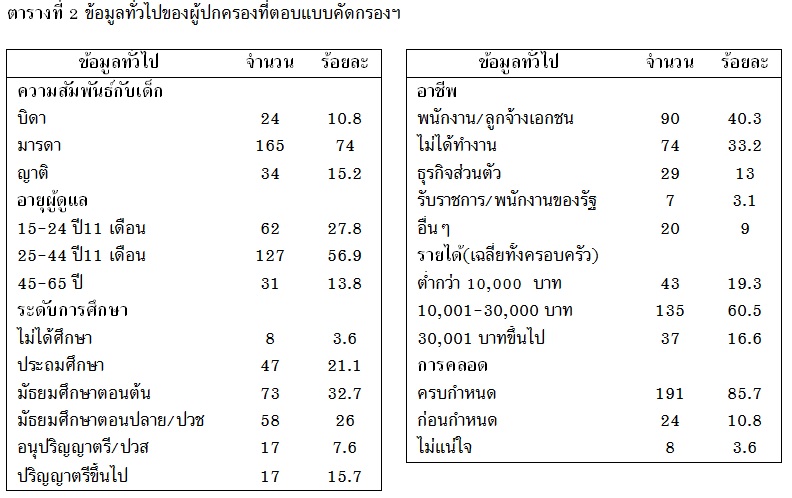Development of the Social-Emotional Developmental Screening Scale for Thai Children Aged 0-48 Months
Keywords:
Scale Development, Emotional Social Development, Thai ChildrenAbstract
The present cross-sectional descriptive study developed a Social-Emotional Developmental Screening Scale for Thai children aged from 0 – 48 months and tested its psychometric properties. The developed scale was created based on the foundation of Functional Emotional Development. This study was divided into two phases. In the 1st phase, to generate items and to test primary qualities of the scale, Item-Objective Congruence Index (IOC) from six expert opinions and internal consistency reliability were examined. The preliminary results found that IOC of the item pool was ≥ 0.5 and Cronbach’s alpha coefficient for the children aged 6-9 months was below the minimum acceptable value. Thus, the items were rewritten. In the 2nd phase, to test the degree to which this scale consistently measures a construct across items, Cronbach’s alpha and corrected item-item total correlation were evaluated by analyzing data from 223 participants. The results indicated that the scale’s final version had moderate to high values of Cronbach’s alpha ranging from 0.604 to 0.904 and the item pool showed the item-total correlation value was more than 0.2. There was a significant difference in scores for normal children (M = 114.57, SD = 25.58) and children with social and emotional developmental difficulties (M = 81.67, SD = 19.34), Z = -4.483, p < .001. The average score of each age group was as follows; aged 0-5 months (M = 20.11, SD = 3.09), 6-9 months (M = 48.96, SD = 5.96), 10-18 months (M = 84.88, SD = 9.90), 19-30 months (M = 103.32, SD = 16.61) and 31-48 months (M = 139.81, SD = 12.28). The analysis of the scale’s psychometric properties resulted in good values of internal consistency and the scale can be used to differentiate children with social-emotional developmental problems from normal children. To gain more benefit from this scale, practitioners should have an understanding of social-emotional developmental concepts.
References
Robert V kail. Children and their Development. 7th ed. United Kingdom: Harlow; 2016.
Robert S. Feldman. Essentials of Understanding Psychology. 7th ed. New York : McGraw-Hill Higher Education; 2005.
Bayley N. Bayley scales of infant and toddler development. 3rded.San Antonio: TX Harcourt; 2006.
Greenspan S, Wieder S. The Child with Special Needs: Encouraging Intellectual and Emotional Growth.United States of America: DA Capo Press; 1998.
แก้วตา นพมณีจำรัสเลิศ และอินทร์สุดา แก้วกาญจน์. กระบวนทัศน์ใหม่การดูแลรักษาเด็กออทิสติกสำหรับกุมารแพทย์.วารสารกุมารเวชศาสตร์ 2560;56:6-15.
Christensen DL, Baio J, Braun KV, et al. Prevalence and characteristics of autism spectrum disorder among children aged 8 Years-Autism and Developmental Disabilities Monitoring Network, 11 sites, United States,
MMWR Surveillance Summaries2018; 67:1-23.
Srisinghasongkram P, Pruksananonda C, Chonchaiya W. Two-Step Screening of the Modified Checklist for Autism in Toddlers in Thai Children with Language Delay and Typically Developing Children. Journal of Autism and Developmental Disorders 2016; 46: 3317-3329.
Greenspan SI. Greenspan Social - Emotional Growth Chart: A screening questionnaire for infants and young children. San Antonio: PsychCorp; 2004.
Briggs, RD., Stettler, EM., Silver, EJ., Schrag, R. D. A., Nayak, M., Chinitz, S., &
Racine, A. D. Social-emotional screening for infants and toddlers in primary care. 2012. Pediatrics 2012; 129:e377–e384.
อดิศร์สุดา เฟื่องฟู. การเฝ้าระวังและติดตามและคัดกรองพัฒนาการเด็กและพฤติกรรมเด็กเล่ม 4. พิมพ์ครั้งที่ 1. กรุงเทพฯ: บริษัท พี. เอ. ลีฟวิ่ง จำกัด; 2561. หน้า 147-175.
สุชีรา ภัทรายุตวรรตน์. คู่มือการวัดทางจิตวิทยา.พิมพ์ครั้งที่ 5.กรุงเทพฯ: เมดิคัล มีเดีย; 2556.
Frederick J Gravetter, Larry B. Wallnau.Essen-
tials of Statistics for the Behavioral Sciences, 7thed. Wadsworth: Paperback; 2008.

Downloads
Published
Issue
Section
License
บทความทุกบทความที่ตีพิมพ์ในวารสารการพัฒนางานประจำสู่งานวิจัย (JPR2R) ถือว่าเป็นลิขสิทธิ์ของวารสารการพัฒนางานประจำสู่งานวิจัย คณะสิ่งแวดล้อมและทรัพยากรศาสตร์ มหาวิทยาลัยมหิดล





